Departmental Stock and Service Vehicles
In addition to stock for carrying customers goods the railway
companies built large numbers of 'departmental' vehicles for their own use.
These were used by the various maintenance departments for transporting men and
materials about the system. Departmental vehicles would not have wandered on to
'foreign' company lines.
The Permanent Way department, responsible for
track maintenance, requires low sided opens and hopper wagons for ballast and
spoil (used ballast), long flat wagons for carrying rail and sleeper wagons
(often carrying sleepers already fitted with the chairs). Ballast and spoil
wagons out numbered all other types in use of the departmental side.
The GWR had
standardised on steel construction for ballast vehicles but the other
pre-grouping companies favoured wooden bodies vehicles and further examples of
these wooden designs were built by British Railways.
The LMS used very
similar wagons for both sleepers and ballast, these had a longer than normal
body on an extended chassis but with a ten foot wheel base (allowing standard
brake parts to be used for repairs). Both wagons had drop-down sides split into
two sections on each side with a removable post in the middle, the difference
between the sleeper version and the ballast wagon was in the ends. The sleeper
wagon had fixed ends with L shaped stanchions, the ballast version had
drop-down ends which required additional hinged steel posts at each corner.
Quite a few of these wagons were inherited by British Railways and they even
built a few more themselves, British Railways called the sleeper wagon Haddock
and the ballast wagon Sole. These wagons lasted in service into the early
1970's at least. The large letter E shown on the sketch is apparently an LMS
marking still in use in 1969.
Fig ___ Ex LMS Sleeper and Ballast wagons
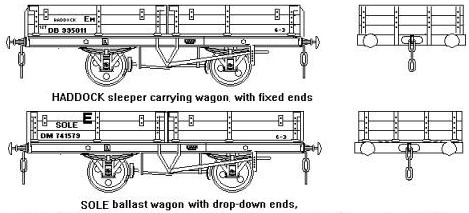
You can make a reasonable representation of these wagons
from a Peco five plank wagon kit and a fifteen foot wheelbase chassis. Remove
the sides of the wagon body and cut the ends down to three planks high. Now cut
the remaining body into two halves about the centre. Take the ten foot
wheelbase chassis and cut the buffer beams off, then cut the ends of a fifteen
foot wheel base Peco chassis just outboard of the wheels and fit these to the
ends of the wagon chassis, this gives you the unusual chassis. Fit the smaller
weight in place on the new chassis and glue the two body ends in place, this
reinforces the joints and keeps things in line. Add 'three plank' sides from
1mm scribed card and detail using 10x20 thou microstrip (for the ballast wagon
add additional 10x20 thou strips to represent the corner and side bars
described above). The photographs on which the drawings are based date from the
late 60's.
Ballast hopper wagons appeared in the 1890's and
side-tipping wagons for both ballast and spoil were also built. The side
tipping wagons used a screw jacking device operated by the workmen to tip the
body and deposit the load beside the track. Once the ballast was on the track
special ballast ploughs (converted brake vans fitted with large plough blades)
were pulled along to spread it out. Having said which on the Southern lines I
gather it was common practice to drop the ballast on the adjacent track then
use men with shovels to move it into place.
In N Gauge
the Parkside Dundas kit range includes a BR standard ballast wagon, the
Grampus, which bears a strong family resemblance to the designs used by the
GWR. They also offer a SR sleeper wagon, introduced in 1928 and still in
service in the late 1980's and the LNER/BR pipe wagon (a design dating from the
1930's and retained into the 1990's for departmental use). The N Gauge Society
offers its members an etched brass kit of a bogie ballast hopper, introduced in
the 1930's, which serves for BR and SR use.
The Fleetline (former Skytex) range
includes two bogie low sided ballast or spoil wagons suitable for NER/LNER and BR eras. All these
kits are discussed under Available Models - Kits. Dapol have released a ready-to-run model of a 'dogfish' four wheel ballast hopper, a rather neat model produced in a number of liveries.
Fig ___ Dapol 'Dogfish' ballast hopper
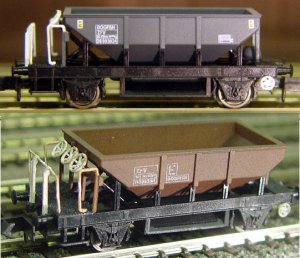
The re-bodied and vacuum braked version of the BR standard 21 ton hopper wagon (available as a kit from the N Gauge Society and as a ready-to-run model from Dapol) was cut down in height and used for ballast traffic from 1988, coded TOPE with the TOPS codes of ZDV and ZCV. These wagons had the simplified side bracing of the re-built hoppers but could be produced from the Society kit by making new sides from card. The sketch below shows a TOPE with, on the left, a standard re-bodied 21 ton hopper for size comparison.
Fig ___ TOPE ballast hopper

Railway companies had to
renew track as the rails became worn and in normal use the sleepers needed
replacing every twenty years or so. Sleepers are relatively light, so to get a
full load within the loading gauge well-type wagons were often used for this
work. I rather like unusual wagons so I built a GWR 'chaired sleeper wagon'
using a Peco chassis and plastic strip. This looked okay but it was not very
strong and is currently in bits having been re-kitted by a youngster. Adding a
load would make this much stronger and in the 1960's some were converted for
use transporting concrete cable trunking on BR/WR. These latter had a wooden
floor and sides added, making for a very robust model. The original T1 GWR
wagons (built at the end of the nineteenth century) have box section side
frames, a later batch built in 1938 (T12) have I section side frames. Some were
piped for vacuum brake and those used for conduit were fitted with a full
vacuum brake. They were just over 34 feet long with a 25 foot wheelbase.
Fig___ GWR T1/T12 Chaired Sleeper Wagon & Concrete Trunking
wagon
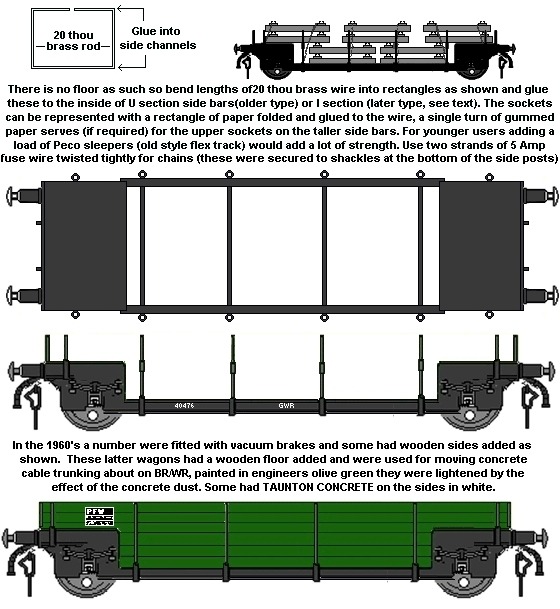
If you do not fancy kit
bashing the Peco chassis and have a deep enough pocket there is a model in the
Fleichman range of a four wheeled, drop centred, wagon which can be modified to
represent a GWR or LMS chaired sleeper wagon, the load would take a fair bit of
time to make up however. This has wide side plates which need to be trimmed
straight and thickened to represent the channel section of the British wagon
but would make a very good basis for a concrete conduit wagon.
To
transport the long rails the railways built low sided four wheeled and later
bogie wagons. The early lines used rails in 30 foot lengths so for my own
'light railway' layout I used a Bachman 'old timer' stake car. This scales out
at something over thirty feet in length and has five pairs of steel posts
mounted in brackets on the body side. Posts mounted in this way are unusual on
British wagons, much more common would be wooden bolsters, but the posts on the
bolsters often extended down below the timber and engaged in similar side
mounted brackets. I trimmed away the centre bracket on the Bachman wagon body
and made up two bolsters using wire and Plastruct H section strip (filling in
the strip with Milliput to represent timber). There are various kits now
available for long bogie flat wagons, notably the N Gauge Society 52 foot long
Bogie Bolster D, which can be pressed into service for Big Four era layouts
when rail lengths were typically about 45 feet. For the post nationalisation
scene there are a number of etched brass kits produced by Mr John Grey of
service stock including a GWR/BR bogie rail wagon (coded Gane under the GWR,
Borail under BR). All these kits are discussed under Available Models - Kits.
In the 1940's track was produced as pre-fabricated sections, rather
like Peco Settrack, which were shifted on rail-carrying wagons and manoeuvred
into position using 'Track Relaying Units' (TRU's). These were originally
conversions based on long bogie wagons with a crude crane at each end. The
cranes usually had electric motors and the vehicle had a van attached in which
was mounted a generator. By the 1960's these track laying wagons were slightly
more advanced in design, converted bogie flat and well wagons fitted with
self-powered Coles diesel cranes at each end. Within a few years self-propelled
specially designed and built TRUs were in service, large very complex and
fitted with crew accommodation cabs and rather difficult to model.
Steam railways used a lot of coal, a major loco depot would get through
up to three thousand tons a week, conversely a small branch line shed might
only require one or two tons a week. To move this coal special 'loco coal'
wagons were built. Most of these were basically similar to standard mineral
wagons but some high capacity bogie vehicles were built by the GWR and the MR
at the turn of the century. Not all coal was shipped in company loco-coal
wagons however, I have seen a photo of Exeter shed which as well as GWR Loco
Coal wagons shows wagons from the Midland Railway, Great Central, and London
& North Western Railways, all delivering coal. Some of the 'foreign' wagons
are marked Loco Coal, but not all. There are kits available for wagons built
for loco coal duties and the Graham Farish seven plank wagon is actually a
model of a North Staffordshire Railway loco coal wagon. There were also a large
number of fairly conventional mineral wagons and even redundant goods wagons
(some as small as three planks high) pressed into service for this traffic.
All companies had to maintain 'breakdown trains', comprising
cranes, coaches equipped for personnel along with some vans and open wagons for
tools and equipment. The cranes used were often large steam powered types,
necessary to lift a de-railed locomotive. These breakdown crane trains would be
usually stabled at major depots but might be seen travelling along any line
en-route to an incident.
The majority of departmental stock has always
been for basic track maintenance, in British Railways days this fell under the
aegis of the Chief Civil Engineer, responsible for bridges, tunnels and
buildings as well as the tracks. The Chief Mechanical Engineer, who's
responsibilities included breakdowns and vehicle failures, had his big cranes
and wagons for shifting defective rolling stock whilst the Signal and Telegraph
department had its wagons for moving telegraph poles signalling equipment. Some
of the stock was older wagons and vans withdrawn from service, British Railways
used three plank and five plank former merchandise wagons as 'spoil' wagons and
a few vans were converted for duties such as cable laying.
Fitted and unfitted version were built, the sketch shows the fitted type.
Fig ___
Short pipe wagon in departmental service

The doors on these wagons must have been very heavy to lift
up, I once felt the weight of a three-plank drop-side and that was heavy
enough.
This is a simple conversion from the Peco five plank wagon. Mine was made by carving and sanding the sides flat and scribing the plank lines across, detail was added with plastic strip (10x20 thou for the side strapping with 10 thou rod for the door springs). It may have been less work to remove the sides and replace them with home made scribed card, again adding detail from strip.
Fig___ Model of the BR short pipe wagon
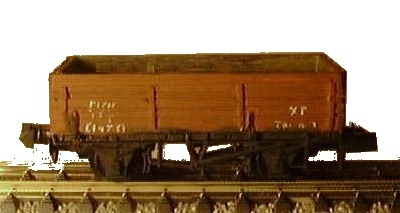
The departmental stock in the post 1967 period has been
increasingly purpose-built, the old 'mess vans' (often converted goods vans
fitted with windows and a set of steps for workers on site) were withdrawn in
the 1970's when British Railways introduced their yellow road vans for
permanent way and signal and telegraph department staff.
Tank wagon
design is considered in a separate section but it is worth noting that the
railway companies operated quite a few tank wagons in departmental service. At
steam engine depots in hard water areas they removed the lime from the water
before using it in the locomotives and the resulting 'sludge' had to be
disposed of. Some of the sludge tanks were of conventional design but redundant
four and six wheeled loco tenders were also widely used. Some of the old
tenders lasted in service into the 1980's, the last would have gone when steam
carriage heating was finally abandoned. The sludge tanks were painted black but
had extensive white staining on the sides where the water had spilled out. If
you see a second hand tender engine for sale as a 'non-runner' (and hence
cheap) it might be worth buying for the tender. You would need to remove any
hint of coal, most of these tenders had the coal space plated over (I am not
sure if this became part of the tank space), so a 'conversion's not difficult
but you also need to add a second coupling to the end formerly connected to the
locomotive.
A number of departmental tank wagons were used for
transporting creosote to the sleeper depots and were conventional tank designs
of their day. The railways also had water tank wagons, some were conventional
tank wagons whilst others were redundant loco tenders or simple tanks mounted
on old underframes. In 1946 the GWR allocated six former six-wheeled milk tanks
for carrying drinking water to outlying stations with no mains supply. This
makes an interesting alternative use for a model tanker on a branch with no
creamery but I was not able to confirm the livery used. One unusual example was
a tank wagon built by BR for supplying water to an on-site concrete mixer
(itself housed in a converted van) used in overhead electrification work. This
vehicle had a large square tank on old wagon or van underframe with the body
cut away leaving only the floor.
Fig __ LMS Creosote tank, British
Railways Water tank and cement mixer van
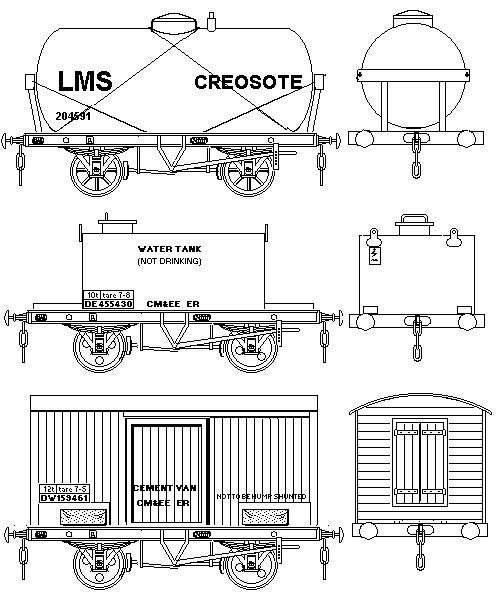
One or two of these departmental water tanks were still
operating in the mid 1980's supplying water for the old steam cranes still in
use. By the 1980's the steam cranes were rare, British Rail preferred
self-propelled diesel units fitted with hydraulic telescopic cranes.
In
the 1990's British Rail still owned a few tanks, some being remarkable vintage
contraptions, most are used for storing oil at loco and DMU stabling points or
MPD's (Motive Power Depots, the term which replaced Engine Shed with the
arrival of the diesels). The two upper tanks in the sketch are drawn from
pictures in Dave Larkin's book on British Railways departmental wagons in the
1960's and 70's. Obvious candidates would be the Peco or Minitrix ten foot
wheelbase tank and the Graham Farish square tank. Both were plain black with
white lettering, note how the fuel oil has smeared the lettering on the square
tank. The bottom tank is based on two I photographed in 1986 at the DMU
stabling point at Northwich in Cheshire. The tank barrels were four riveted
tube sections with flat ends, the edges of the ends were very slightly rounded
and there were four heavy (four inch or 100mm) bolts on each end. The tanks
were mounted on old steam engine tender chassis, the centre wheels and their
associated axle boxes had been removed as shown.
Something similar
could be made up using a Graham Farish tender chassis with a home made tank (as
per the sketch) in which case a 'welded' tank would be easier. The filler domes
on the W&T twin tank kit would be perfect, failing which make a small hole
and fit the cut-off head of a dress making pin. The centre wheels on the tender
chassis could remain in place if you wished. The 'livery' of these converted
tenders when I saw them was a black chassis with everything above plain pale
red oxide (Humbrol 'track colour' mixed with a little white) with no visible
markings. The lids on the filler domes were a dark brown colour.
Also
at Northwich was a lagged tank of the Minitrix type, again painted all over
faded red oxide colour, the diagonal rods to the end supports were painted
white as were the turn buckles on the two wire strops passing either side of
the filler dome. The lid of the filler dome was again a dark brown colour and
the chassis was black.
Fig ___ Fuel tanks for a DMU stable or
MPD
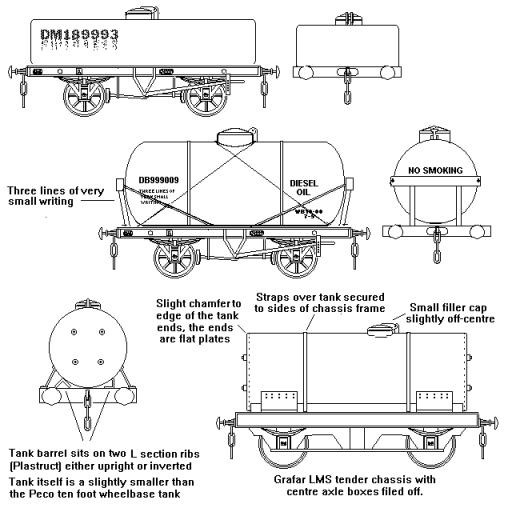
The railways used gas for heating lighting and cooking, the
gas cylinders slung underneath coaches were of limited capacity however so
additional cylinders were mounted on small railway trucks. These could be
loaded and attached to a train or, more commonly, they could be used to top up
the gas tanks on the coaches or at outlying stations and depots. By the later 1940s attaching these to passenger trains was frowned upon, perhaps because the old coach underframes on which many were built were not up to the 'high speed' services then in effect. The gas used
was coal gas, the railways had their own gas works and could also arrange to
buy gas from town gas works on the route (most of which would be rail
connected). Several pre-grouping companies, all the Big Four and British
Railways all operated gas tanks of this type, the earliest photograph I have
seen was taken in 1909 on the Great Northern Railway which resembled the wooden
chassis example in LNER livery shown below. The most common design had two or
three cylindrical tanks mounted along the wagon and the drawings below are
based on the W&T white metal twin-tank wagon kit which is close enough to
pass muster in the liveries shown.
The only problem is that the
standard Peco ten foot wheelbase chassis is a bit on the short side when
working with passenger stock, the GWR version described below can pass muster but other
companies favoured a twelve foot wheelbase. The LMS used a W&T sized tank (well a bit longer) on a 12' wheelbase chassis, this can be modelled on a cut-down Peco 15' wheelbase chassis or a Parkside Dundas chassis, adding a plasticard platform at one end with handrails across both ends as shown i the sketch The liveries shown are correct for
the larger tanks and W&T (now sold via Scale Link) can offer additional lengths of tubing, allowing
longer tanks to be produced.
Fig ___
Railway Company Gas Tank wagons
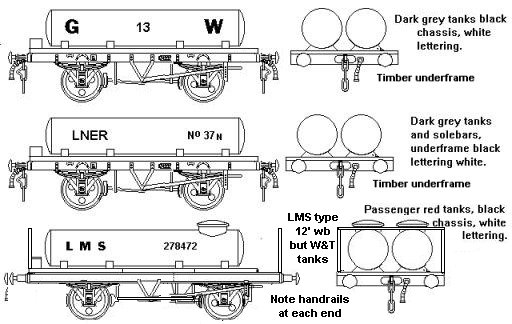
The W&T kit on a Peco wooden
chassis makes a passable GWR gas tank wagon, omit the filler domes and add a T
shaped pipe at the end with the 'boxes' (just visible in the photo), this
connects the two tanks and feeds down through the floor of the wagon. Note the
number on this tank should be 13, it was the only one of its type and the only
short wheelbase tank I was definitely able to identify. The tanks and chassis
were all black (very dark grey looks better in N as colours lighten with
distance).
Fig___ GW
twin gas tank wagon made from the W & T kit
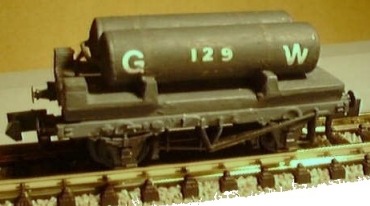
The GWR also used a larger multi-tank wagon which looked like a
stack of rather large oil drums mounted across the wagon in a heavy looking
metal frame. This represents a serious challenge for the scratch builder
however.
In the later 1920's or early 1930's several larger gas tank
wagons were built based on a single large tank. I have not been able to trace
the operational details but a model of such a tank is not difficult to
construct. The LMS built two quite large tanks using fifteen foot wheelbase
chassis, the tanks themselves being mounted conventionally for the time in a
frame with straps to hold them down and end stanchions to hold them in
position. Something quite similar can be built using a Peco fifteen foot
wheelbase chassis and a Peco ten foot wheelbase tank kit body. Cut the
sub-frame from the Peco in half and glued to the chassis. Next cut away the
centre section of the tank and add a length of tube (or paper wrapper) in its
place to extend the tank to the required length.
There were also wagons
delegated for delivering coal and collecting ash from signal boxes. These were
usually standard open wagons of conventional design but they represent an
interesting option for operational traffic. Horses consumed a lot of hay and
produced considerable quantities of manure. The cattle pens at stations
handling a lot of this kind of traffic would also have a lot of manure to be
disposed of. This was not thrown away as it was a useful fertiliser. Several
companies built specialised wagons for collecting manure, as manure is not very
dense these wagons usually had larger than normal bodies. Most of this material
was shipped in plain mineral wagons, where the potential for contamination
would be less of a problem. As recently as the 1950's BR was shifting over two
million tons of manure a year. Some of this was single wagon loads from the
stables used for goods shunting horses and few remaining delivery horses at
stations, some was shifted in a rake of wagons from a major cattle centre (such
as the docks where cattle were imported or from stations with extensive cattle
pens following a market).
The railways have to contend with weeds
growing in the ballast along the line which interfere with drainage and could
make the track unstable. In the early years the gangers walking the line were
expected to deal with the weeds but by the mid 1930's weed-killer trains were
being operated by the larger companies (liquid weed-killers had been around
since the 1890's at least). Weeds are difficult to kill however and on branch
lines and 'light railways' there were often weeds growing along the track.
Early weed killing trains were operated by the railway company
themselves, initially they consisted of a short rake of redundant locomotive
tenders filled with the weed killing solution. The tenders were connected
together with fairly large pipes (about four or five inches (100 125mm)
diameter) and the locomotive provided steam which was used to force the
solution out of a series of spray rails on the rear of the last tender.
By the 1940's these trains were made up of three or four old loco
tenders to carry the water, a tank wagon to carry the liquid weed killer, a
pump/spray vehicle (often a converted long wheelbase or bogie van), a
stores/mess van (usually a converted coach) and a brake van or two. Having a
van at each end made it easier for the locomotive to run-round the train for
the return journey. By the 1950's there were usually four or six tank wagons or
redundant six wheeled locomotive tenders (or a mixture of both) carrying a
ready mixed solution of weed killer, pump van, mess van and brake van(s).
British Railways employed private contractors for this work from about
the 1960's, originally Fissons the fertiliser people handled the job, and up to
the 1970's the equipment remained as before. Since then the contract has passed
to Hunslet Barclay of Kilmarnock who employed a train consisting of two
modified bogie parcels vans with three four wheeled forty five ton tank wagons
(of the type offered by Peco). The rake was normally handled by Class 20
locomotives, often operated as a pair and owned by Hunslet Barclay themselves.
The locomotives were subsequently sold to Direct Rail Services for use on their
freight trains. I do not know who now handles the weed killing duties.
Fig___ Weed Killer Trains

On
the departmental side the Fleetline range includes a Cowan Sheldon hand powered
rail crane dating from the 1950's and a pre-war 45 ton steam crane. Parkside
Dundas offer the 'grampus' ballast and spoil wagon and of course the
departmental stock inherited from the Big Four and available from Fleetline
continued in use for many years.
Following the Beeching changes and
Barbara Castle's Transport Act there were large numbers of redundant open
wagons transferred to the engineers, notably the drop-side three plank wagons
as available from Fleetline.
One odd option seldom modelled is the 'match wagon' used to allow a vehicle with non-standard couplings to be attached to a train or hauled by a locomotive. One example is the old Palbrick wagons which were modified to couple up to individual Freightliner 'inner' wagons and other types of non-standard stock. These were painted plain blue with the TOPS codes RGQ and RFQ and had the sides removed, although otherwise they were unmodified as far as I could see. The last time I recall seeing one of these in use was in the later 1980s, although they may well have lasted a lot longer as they would recieve little wear and tear.
Fig___ Palbrick based match wagon
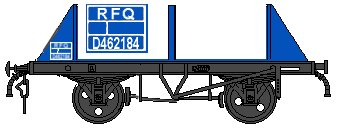
Generally these are confined to yards where such stock may be taken out of service, but some match vehicles are used to transport non-standard stock on the system.
The example below is the match wagon used to pull the Eurostar set about (last used in the later 1990s I believe, whern there was the promise of a Eurostar service direct from the North West of England). I believe the photo was taken in the later 1990s, but cannot confirm the exact year. The unit was being held in a bay platform at Stockport station, the base ofr the service was at the former Freightliner yard in Longsight (South of Manchester), now used as a service point for more mundane multiple units.
Fig___ Eurostar match wagon
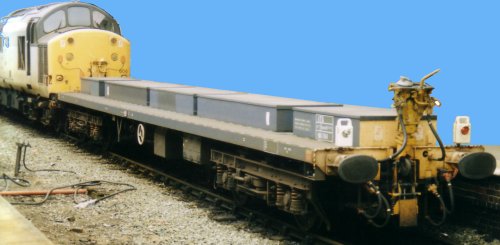
The close up below shows the hinged coupling bar on the Eurostar end of the wagon.
Fig___ Eurostar match wagon couping
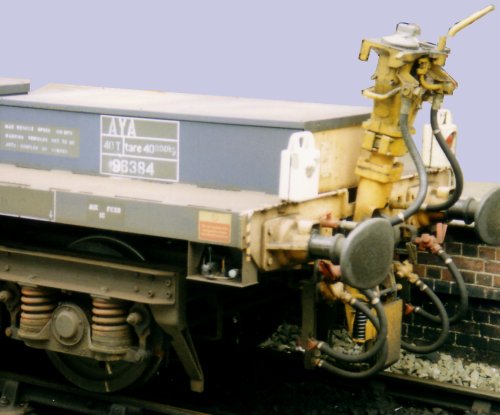
^
Go to top of page
International Good Guys ~ Making the world a
better place since 1971 ~ Site maintained by

All material Copyright © Mike
Smith 2003 unless otherwise credited













